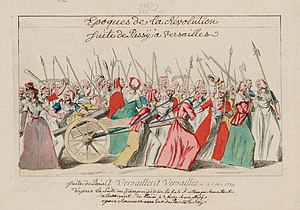
Back Lebensmittelunruhen German Motín de subsistencias Spanish Janari-matxinada Basque Rivolta del pane Italian Voedseloproer Dutch

A food riot is a riot in protest of a shortage and/or unequal distribution of food. Historical causes have included rises in food prices, harvest failures, inept food storage, transport problems, food speculation, hoarding, poisoning of food, and attacks by pests.[1]
Studies of food riots have found that they are often preceded by conditions of economic desperation, at which point members of the public may attack shops, farms, homes, or government buildings to attain staple foods such as bread, grain, or salt, as in the 1977 Egyptian bread riots.[2] Historically, food riots are part of a larger social movement, such as the Russian Revolution or the French Revolution.[3] Historically, women have been heavily involved in leading food riots; food riots have thus served as a form of female political action even in societies without women's suffrage or other guaranteed political rights.[4]
- ^ Patel, Raj; Philip McMichael (2009). "A Political Economy of the Food Riot". Review (Fernand Braudel Center). 32 (1): 9–35. JSTOR 40647787.
- ^ "Egypt battle toll: 43 dead". The Age. 21 January 1977. Retrieved 25 March 2013.
- ^ Walton, John K.; Seddon, David (2008). Free markets and food riots: The politics of global adjustment. Cambridge MA: John Wiley & Sons. ISBN 978-0-631-18245-0.
- ^ Thompson, E.P. (1993). Customs in Common: Studies in Traditional Political Culture. New York: The New Press. pp. 233–234.
© MMXXIII Rich X Search. We shall prevail. All rights reserved. Rich X Search